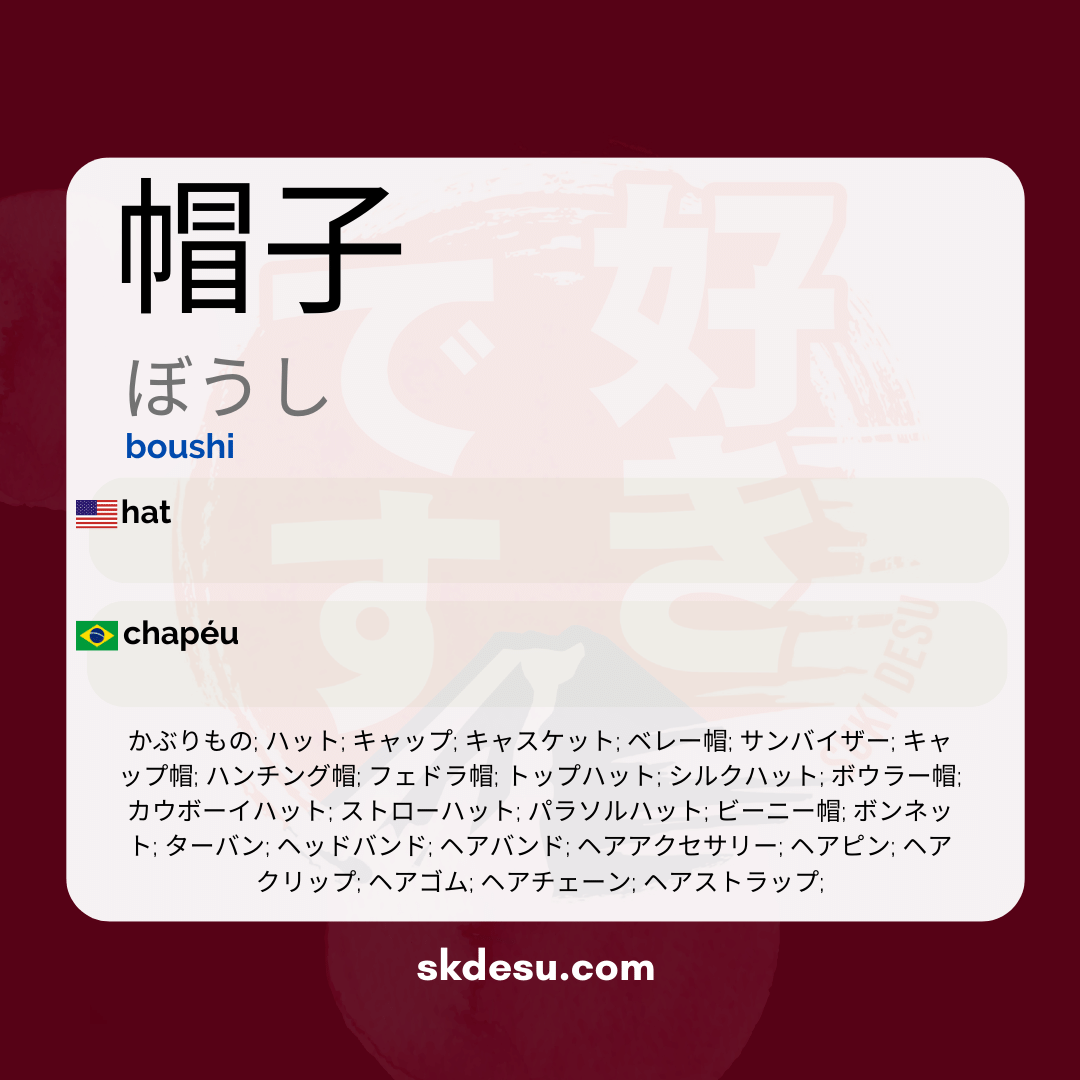Translation and Meaning of: 帽子 - boushi
On this page, we will study the meaning of the Japanese word 帽子 (boushi) and its translation into English. Let's see their different meanings, example phrases, explanations, etymology and the similar words.
Romaji: boushi
Kana: ぼうし
Type: noun
L: jlpt-n5
Translation / Meaning: hat
Meaning in English: hat
Definition: Decorative clothing that covers the head for sun protection and heat retention.
Sumário
- Etymology
- Vocabulary
- Writing
- Phrases
Explanation and Etymology - (帽子) boushi
The Japanese word 「帽子」 (boushi) refers to an everyday item that many of us wear: the hat. In the Japanese language, this word is made up of two kanji: 「帽」 (bou) and 「子」 (shi). The etymology of these kanji reveals a deeper and more interesting meaning. 「帽」 (bou) means "hat" or "cap" by itself, while 「子」 (shi), which generally means "child" or "son/daughter", in this combination acts merely as a common suffix in words related to personal objects, without necessarily bringing its literal meaning.
From a historical perspective, the use of hats in Japan can be traced back to ancient times, but the word 「帽子」 (boushi) has become established in modern Japanese vocabulary with Western influences. During the Edo period, hats were not commonly worn in daily life unless for practical reasons, such as protecting oneself from the sun during agricultural work. With the Meiji Restoration, Western influences introduced a greater variety of hats, brought by Westerners who began to settle in Japan, incorporating this accessory into the clothing of the urban population.
Nowadays, 「帽子」 (boushi) is a widely used term to describe any head covering, from a simple baseball cap to an elegant felt hat. The term encompasses a variety of styles and functions, including protection from the sun, decoration, and as a fashion item. The use of hats is so popular that there are even specialty stores called 「帽子屋」 (boushiya), meaning literally "hat store." These stores offer an incredible range of options that reflect fashion trends and the rich Japanese cultural tradition of adaptation and reinvention.
The word 「帽子」 (boushi) represents more than just a piece of clothing; it reflects Japan's cultural evolution over the centuries and its ability to assimilate and transform external influences. From the classic samurai hats known as 「笠」 (kasa) to modern creations inspired by Western styles, hats are accessories that transcend mere practical function to become important items of personal and cultural expression.
Synonyms and similar words
- かぶりもの (kaburimono) - It generally refers to any type of head covering.
- ハット (hatto) - A generic term for large hats.
- キャップ (kyappu) - A type of hat with a front brim, common in outdoor activities.
- キャスケット (kyasuketto) - Hat with a short brim, often associated with vintage styles.
- ベレー帽 (berēbō) - A round, flat hat, usually made of wool or felt.
- サンバイザー (sanbaizā) - An accessory that covers the top of the head but leaves the face exposed, ideal for sun protection.
- キャップ帽 (kyappubō) - Another term for "cap" style hat, commonly used in sports.
- ハンチング帽 (hanchingubō) - "Hunting" style hat, typically with a short brim, used for protection and style.
- フェドラ帽 (fedorabō) - Classic hat with a wide brim and a crease on the top.
- トップハット (toppuhatto) - High cylindrical hat, often associated with formal occasions.
- シルクハット (shirukuhatto) - High-class hat, made of silk, similar to the top hat.
- ボウラー帽 (bōrābō) - Round-shaped hat, popular at social and sports events.
- カウボーイハット (kaubōihatto) - Cowboy hat, with a wide brim, very associated with the American West.
- ストローハット (sutōrohatt) - Straw hat, ideal for summer and outdoor activities.
- パラソルハット (parasoluhatto) - Hat with extra sun protection, usually with a large brim.
- ビーニー帽 (bīnībō) - A knit hat that fits the head, ideal for cold weather.
- ボンネット (bonetto) - Traditional women's hat, typical in old styles, usually with a wide brim.
- ターバン (tāban) - A cloth wrapped around the head, used by various cultures.
- ヘッドバンド (heddobando) - Accessory worn on the head, usually used to keep hair in place or absorb sweat.
- ヘアバンド (heabando) - Similar to the headband, used for styling or functionally.
- ヘアアクセサリー (heaakusesarī) - Generic term for any accessory used in hair.
- ヘアピン (heapin) - Used to hold hair in place.
- ヘアクリップ (heakurippu) - Accessory used to hold hair more securely.
- ヘアゴム (heagomu) - Elastic used to tie hair in ponytails or buns.
- ヘアチェーン (heachēn) - Chain or link used as a hair accessory.
- ヘアストラップ (heasutorappu) - Headband or strip used to hold hair or serve as an accessory.
Words related
Words with the same pronunciation: ぼうし boushi
How to Write in Japanese - (帽子) boushi
See below a step-by-step guide on how to write the word by hand in Japanese (帽子) boushi:
Example Sentences - (帽子) boushi
Below are some example sentences:
Boushi wo kaburu
Put on a hat.
Wear a hat.
- 帽子 - It means "hat" in Japanese.
- を - It is a particle of object in Japanese, indicating that the hat is the object of the action.
- 被る - It is a verb that means "to wear" or "to dress" in Japanese, in this case referring to the act of putting on a hat.
Wara de tsukurareta boushi wo kabutte iru
I am wearing a hat made of straw.
I wear a hat made of straw.
- 藁 (wara) - straw
- で (de) - binding particle
- 作られた (tsukurareta) - was made
- 帽子 (boushi) - hat
- を (wo) - direct object particle
- かぶっている (kabutteiru) - is using
Other words of the same type: noun
See other words from our dictionary that are also: noun

